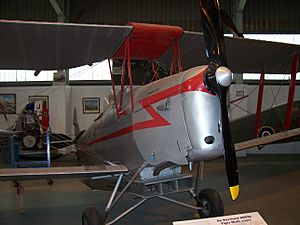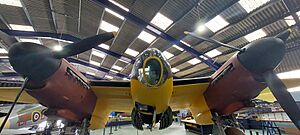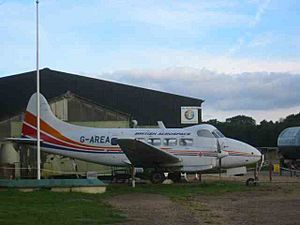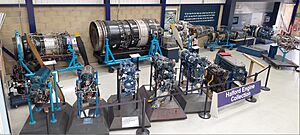- This page was last modified on 17 October 2025, at 10:18. Suggest an edit.
de Havilland Aircraft Museum facts for kids
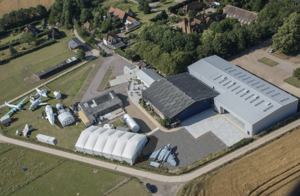 |
|
| Lua error in Module:Location_map at line 420: attempt to index field 'wikibase' (a nil value). | |
| Former name |
|
|---|---|
| Established | 1959 |
| Location | London Colney, Hertfordshire, United Kingdom |
| Type | Aviation museum |
The de Havilland Aircraft Museum is a special museum in Hertfordshire, England, run by volunteers who love airplanes. It is the only museum in the country dedicated to just one aircraft maker: the de Havilland company.
The museum's goal is to protect the amazing history of de Havilland aircraft. They want to show everyone how this company helped create new and exciting technology for British aviation.
The collection started with the very first de Havilland Mosquito ever built. This famous plane was designed and built right here! The museum also has several de Havilland Vampire jets, which was the third jet-powered aircraft to ever fly.
Contents
The Museum's Story
Salisbury Hall: A Historic Home
The museum is located at a place called Salisbury Hall, which has a long and interesting history. The current house was built around 1668 for a banker named James Hoare. It is said that King Charles II and his friend Nell Gwynne were connected to the hall.
Over the years, many different people lived here. In the early 1900s, Lady Randolph Churchill, the mother of Winston Churchill, lived at the hall. This meant that the future prime minister was a frequent visitor.
Later, in the 1930s, Sir Nigel Gresley lived here. He was a famous railway engineer who designed the Mallard, the world's fastest steam train. It is believed he named the locomotive after the ducks living in the moat around the hall!
A Secret Wartime Project
In 1939, at the start of World War II, the de Havilland Aircraft Company needed a secret place to design a new plane. They chose Salisbury Hall. Here, a team worked on the famous de Havilland Mosquito. The very first Mosquito prototype, W4050, was built in sheds next to the hall.
After the war ended, de Havilland left in 1947, and the beautiful hall became neglected and run-down.
Saving the First Mosquito
A retired army major named Walter Goldsmith bought the old hall. He soon learned about its secret wartime past. He contacted de Havilland and found out that the original Mosquito prototype still existed! It had been hidden away and was almost thrown out.
Mr. Goldsmith offered to give the historic plane a home at Salisbury Hall. De Havilland fixed up the plane, and in 1959, it returned to the place where it was born. This was the beginning of the museum.
Growing the Collection
The prototype Mosquito was the first plane on display. Soon, other famous de Havilland aircraft joined it, like the de Havilland Vampire and Venom. In 1970, another Mosquito arrived. This one had been used in the movie Mosquito Squadron.
Over the years, the museum added more planes, including a Sea Vixen, a Chipmunk, and a Dove. The museum also has the body of the world's first jet airliner, the de Havilland Comet 1.
Volunteers have done amazing work restoring these planes. In 2001, they began a huge project to conserve the original Mosquito prototype, which was finished in 2015 for its 75th anniversary. Today, you can see it displayed with two other Mosquitos in one of the museum's hangars.
The Aircraft Collection
The museum has a fantastic collection of aircraft. Some are fully restored, while others are still being worked on by the dedicated volunteers.
Aircraft on Display
Here are some of the amazing planes you can see at the museum:
- Airspeed Horsa I/II BAPC.232 – The body of a WWII glider
- British Aerospace 146-100 G-JEAO – The body of a modern jet
- Cierva C.24 G-ABLM – An early type of autogyro
- de Havilland DH.53 Humming Bird J7326 – The body of a very light aircraft
- de Havilland DH.82 Tiger Moth G-ANRX
- de Havilland DH.82 Queen Bee LF789 – The body of a radio-controlled drone
- de Havilland DH.87 Hornet Moth G-ADOT
- de Havilland DH.88 Comet G-ACSR – A replica of a famous racing plane
- de Havilland DH.98 Mosquito Prototype W4050
- de Havilland DH.98 Mosquito FB.VI TA122/TW233
- de Havilland DH.98 Mosquito TT(B)35 TA634
- de Havilland DH.100 Vampire FB.6 J-1008
- de Havilland DH.103 Hornet VX250 – The tail section of a fighter plane
- de Havilland DH.104 Dove 8 G-AREA
- de Havilland DH.106 Comet 1A F-BGNX – The body of the first jet airliner
- de Havilland DH.106 Comet 1A G-ANAV – The nose section
- de Havilland DH.106 Comet C.2(R) XK695 – The cockpit section
- de Havilland DH.106 Comet 2 – The nose section
- de Havilland DH.110 Sea Vixen FAW.2 XJ565
- de Havilland DH.114 Heron G-AOTI
- de Havilland DH.115 Vampire T.11 XJ772
- de Havilland DH.125 Series 1 G-ARYC
- de Havilland Canada DHC-1 Chipmunk T.10 WP790
- Hawker Siddeley HS.121 Trident 2E G-AVFH
Aircraft in Storage
These planes are waiting for their turn to be restored and displayed.
- de Havilland DH.98 Mosquito TT.35 TJ118 – Fuselage, with nose section removed.
- de Havilland DH.100 Vampire FB.5 VV217
- de Havilland DH.104 Dove 6 D-IFSB
- de Havilland DH.112 Venom FB.4 WR539
- de Havilland DH.112 Venom FB.50 J-1632
- de Havilland DH.112 Venom FB.54 J-1790
- de Havilland DH.112 Venom NF.3 WX853
- de Havilland DH.113 Vampire NF.10 WM729 – fuselage pod only
- de Havilland DH.125 Jet Dragon G-ARYA – Cockpit section only
Aircraft Under Restoration
Volunteers are currently working on these exciting projects.
- de Havilland DH.89A Dragon Rapide G-AKDW
- de Havilland DH.112 Sea Venom FAW.22 XG730
Engines on Display
The museum also has a large collection of engines that powered these amazing aircraft. You can see how aviation technology changed over time, from piston engines to powerful jets.
- Piston Engines
- de Havilland Iris (replica)
- de Havilland Gipsy
- de Havilland Gipsy Major
- de Havilland Gipsy Queen
- de Havilland Gipsy Twelve
- Rolls-Royce Merlin
- Gas Turbine (Jet) Engines
- de Havilland Ghost
- de Havilland Goblin
- de Havilland Gyron
- de Havilland Gyron Junior
- Rolls-Royce Gnome
- Turboprop Engines
- de Havilland H3
- Rocket Engines
- de Havilland Super Sprite
- de Havilland Spectre
See also
- List of aerospace museums


